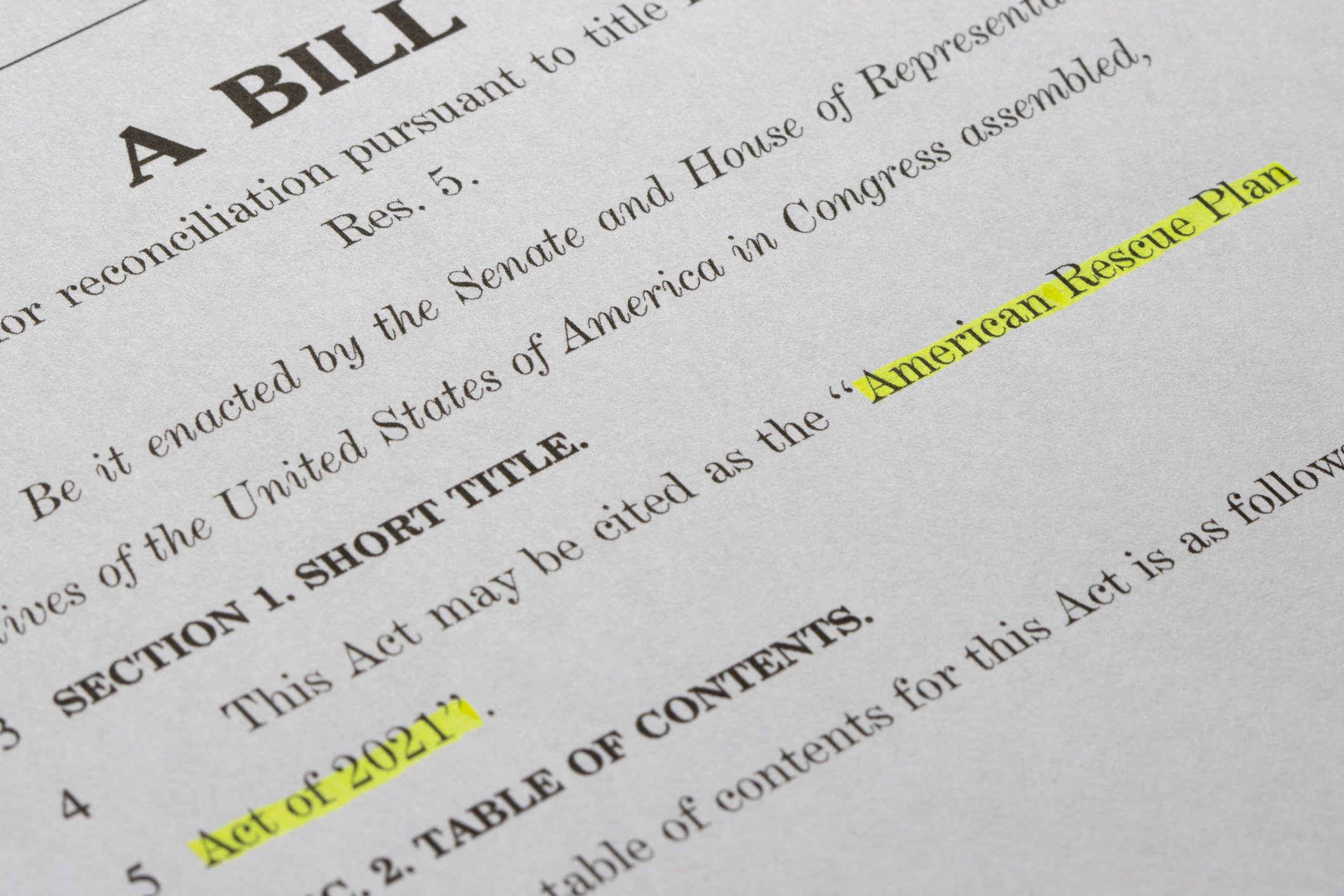
Billions of dollars in federal COVID-19 recovery funds are flowing to American schools.
Money has been allocated from the March 2020 Coronavirus Aid, Relief, and Economic Security Act (CARES Act), much of which has been obligated or already spent to support curriculum, instruction, and student support services, and there are billions more available from the Coronavirus Response and Relief Supplemental Appropriations Act (CRRSA), passed by Congress in December, and the American Rescue Plan from earlier this year. The US Department of Education allocated money based on each state’s need, which essentially focused on helping districts reopen schools and allocated a variety of individual funds to categories like transportation, curriculum, and cleaning/maintenance. Keep reading to learn more about the various sources of COVID-19 relief for schools and ideas for how schools can utilize these funds for maximum benefit.
 Photo: iStock by Getty Images / Andrii Dodonov
Photo: iStock by Getty Images / Andrii Dodonov
The CARES Act
The CARES Act is the stimulus bill that passed in March 2020 and was the first of federal measures to support K–12 schools during the pandemic. It earmarked $30.7 billion under an Education Stabilization Fund for states to spend on education, including $13.2 billion for the Elementary and Secondary School Education Relief Fund and $14 billion for the Higher Education Emergency Relief Fund. States are free to decide how the funds are allocated to various districts, but the money in each state must be spent by September 2022.
The law lists twelve possible uses for the $13.2 billion in the package’s K–12 relief fund:
- Any activity authorized by the ESEA of 1965, including the Native Hawaiian Education Act and the Alaska Native Educational Equity, Support, and Assistance Act, the Individuals with Disabilities Education Act, the Adult Education and Family Literacy Act, the Carl D. Perkins Career and Technical Education Act of 2006, or subtitle B of title VII of the McKinney-Vento Homeless Assistance Act
- Coordination of preparedness and response efforts of local educational agencies with state, local, tribal, and territorial public health departments, and other relevant agencies, to improve coordinated responses among such entities to prevent, prepare for, and respond to coronavirus
- Providing principals and others school leaders with the resources necessary to address the needs of their individual schools
- Activities to address the unique needs of low-income children or students, children with disabilities, English learners, racial and ethnic minorities, students experiencing homelessness, and foster care youth, including how outreach and service delivery will meet the needs of each population
- Developing and implementing procedures and systems to improve the preparedness and response efforts of local educational agencies
- Training and professional development for staff of the local educational agency on sanitation and minimizing the spread of infectious diseases
- Purchasing supplies to sanitize and clean the facilities of a local educational agency, including buildings operated by such an agency
- Planning for and coordinating during long-term closures, including for how to provide meals to eligible students, how to provide technology for online learning to all students, how to provide guidance for carrying out requirements under IDEA, and how to ensure other educational services can continue to be provided consistent with all federal, state, and local requirements
- Purchasing educational technology (including hardware, software, and connectivity) for students who are served by the local educational agency that aids in regular and substantive educational interaction between students and their classroom instructors, including low-income students and students with disabilities, which may include assistive technology or adaptive equipment
- Providing mental health services and supports
- Planning and implementing activities related to summer learning and supplemental after-school programs, including providing classroom instruction or online learning during the summer months and addressing the needs of low-income students, students with disabilities, English learners, migrant students, students experiencing homelessness, and children in foster care
- Other activities that are necessary to maintain the operation of and continuity of services in local educational agencies and continuing to employ existing staff of the local educational agency (California Department of Education, 2021; Jordan, 2021)

Photo: iStock by Getty Images / hapabapa
The American Rescue Plan Act
Signed into law by President Biden on March 11, 2021, the ARPA legislation has been the largest federal funding boost for American schools in modern history, allotting $125 billion to K–12 school districts and state education departments. With the majority of funds intended to address learning loss due to the pandemic and support socioeconomically disadvantaged students, whom data report have been hit hardest by remote instruction, there is a lot at stake for how states and districts spend the money (Waters, 2021).
Money from the ARPA can be used for a variety of school needs as long as districts direct 20 percent funds to address gaps in learning. The bill gives suggestions like “summer learning or summer enrichment, extended day, comprehensive after-school programs, or extended school year programs” for students who have had difficulties with distance learning to meet this stipulation. States and districts must use all allotted funds by October 2024.
Unlike the CARES Act, the recommendations regarding fund usage are much more broad in the ARPA. There is money within the bill set aside to support specific student populations, which says that funds must be used on “activities to address the unique needs of low-income children or students, children with disabilities, English learners, racial and ethnic minorities, students experiencing homelessness, and foster care youth” (National Conference of States Legislatures [NCSL], 2021). This includes an allotment of $2.5 billion for students with disabilities, $200 billion for preschool programs, $800 billion for homelessness youth, and $850 million for Bureau of Indian Education–operated elementary and secondary schools.
Otherwise, the rest of the funds are flexible and can be used for a wide array of school infrastructure, curriculum, or teaching needs, “including repairing ventilation systems, reducing class sizes and implementing social distancing guidelines, purchasing personal protective equipment, and hiring support staff to care for students’ health and well-being” (NCSL, 2021).
 Photo: iStock by Getty Images / DNY59
Photo: iStock by Getty Images / DNY59
How to Spend the Funds
In March 2021, the Department of Education released five questions for districts to consider when evaluating the whether the proposed spending is appropriate:
1. Will the proposed use of funds “prevent, prepare for, and respond to Coronavirus?”
2. Is it an allowable use of funds under any of the relief packages?
3. Is it reasonable and necessary?
4. Does it promote equity?
5. Does it support returning students to the classroom?
Along with the various stipulations for funds, districts can use these questions to formulate pandemic spending plans for the money. Additionally, this article from FutureEd, called “Perspectives on How Schools Should Spend Covid Relief Aid,” is a great starting point for how to invest in areas that will make the most difference for students and teachers. With a little over a year left for spending CARES Act funds and three years left for the ARPA, districts should consider the academic, socio-emotional, and technological impacts that the pandemic has had on their schools and plan accordingly to address learning loss, future educational trends, and student mental health.
Active Classroom provides a digital technology solution to address learning loss
Try a free 30-day trial today
References
California Department of Education. “Federal Stimulus Funding.” Finance & Grants. Last reviewed April 8, 2021. https://www.cde.ca.gov/fg/cr/.
Jordan, Phyllis W. “What Congressional Covid Funding Means for K–12 Schools.” FutureEd. Last updated April 13, 2021. https://www.future-ed.org/what-congressional-covid-funding-means-for-k-12-schools/.
National Conference of States Legislatures. “American Rescue Plan Act of 2021.” Last modified March 9, 2021. https://www.ncsl.org/ncsl-in-dc/publications-and-resources/american-rescue-plan-act-of-2021.aspx.
Waters, Laura. “Explained: The American Rescue Plan Gives a Huge Boost to School Funding.” Better Conversation (blog), April 10, 2021. https://educationpost.org/explained-the-american-rescue-plan-gives-a-huge-boost-to-school-funding/.
Monet Hendricks is the blog editor and social media/meme connoisseur for Social Studies School Service. Passionate about the field of education, she earned her BA from the University of Southern California before deciding to go back to get her master’s degree in educational psychology. She currently attends the graduate program at Azusa Pacific University pursuing advanced degrees in school psychology and Applied Behavior Analysis. Her favorite activities include watching documentaries on mental health and cooking adventurous vegetarian recipes.